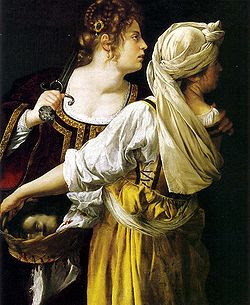 |
| Self Portrait, Artemisia Gentileschi, |
Many successful women artists during the Renaissance came from Bologna, no doubt for the fact that it had a university which was known for educating woman as well as woman saint who painted. However, even these artists, skilled and renowned, were considered the exception and their talent nothing short of miraculous. These women had to endure severe criticisms of their work and their character. Many of them were the daughters of father painters who it was said were the true painters of their work. It’s clear that they possessed a commitment and a drive to create their art that took precedence over adhering to the social norms of their day no doubt from enduring prejudice toward their work which they knew, being so skilled, was unjustified.
Artemisia Gentileschi was born in Rome, July 8, 1593. She was the eldest child of Tuscan painter, Orazio Gentileschi. Due to her father's influence, and inspired by Caravaggio, she became one of the most accomplished painter's of her generation and the first female painter to become a member of Accademia di Arte del Disegno in Florence.
Gentileschi has been described as a “challenge to humanist constructions of feminine education and deportment” (Chadwick, Women, Art & Society), which seems to be the major theme of her life as well as her work. Gentileschi’s talent as a painter was clear, however, on the basis of her being a woman, she was not allowed to attend the academy. Instead, she worked with her father and her brothers in her father's workshop. Later, her father hired Agostino Tassi, who he was working with to paint the inside of the vaults of Casino della Rose inside the Pallavicini Rospigliosi Palace in Rome to tutor his daughter privately. Tassi was brought up on charges of raping Artemisia, the withdrawal of a promise of marriage as well as stealing a Gentileschi painting. There are conflicting seventeenth century documents which not only make it difficult to ascertain exactly what actually happened but also further point to the socio-politically charged situation of the day making Artemisia quite a controversial figure if not a revolutionary one. Artemisia seems to become the poster child for what happens to a woman if she steps “out of bounds.” However, later in her life, she enjoys much success and even marries and has a child. She appears to have satisfied both societal expectations as well as the desires of her artistic self.
Agnes Merlet’s film, Artemisia, successfully illuminates the complicated, political situation and it’s clear that all involved, Tassi, Orazio, Artemisia, even Tassi’s sister, as well as those prosecuting Tassi and the judge, have different values and motivations making the truth difficult to ascertain. As we watch the court drama unfold, the film makes it clear that the court case was more about the social beliefs and papal laws of the time regarding the role of women. In particular, the laws making it illegal for women to paint nudes (as was typical for artists in academic settings), becomes evidence against Artemisia in an effort to clear Tassi of wrongdoing and her paintings and drawings of male nudes are shown around the courtroom to gasps and groans. Orazio attempts to protect his daughter by claiming that the paintings and drawings are his. Artemisia’s own father though supportive of her painting he is, clearly has his own agenda and is determined to make Tassi pay for violating and stealing his property. Artemisia is even subjected to torture to exact the “truth” from either herself or from the watching Tassi who “confesses” to raping her in order to cease her torture. Tassi is given two years in prison but apparently never served time having been acquitted.
 |
| Judith and Her Maidservant, Artemisia Gentileschi, 1613-14, oil on canvas, Palazzo Pitti, Florence |
The fact that Artemisia focused and worked hard as a painter is clear. Her life was marked by a sustained artistic production despite the fact that she married and had children. This was achieved by very few women artists especially in Gentileschi’s time. The strength and courage displayed in her character is also displayed in her paintings, showing power and even violence in such provocative paintings as, Judith with her Maidservant and Judith Decapitating Holofernes.
 |
| Judith Slaying Holofernes, Artemisia Gentileschi, 1614-20, oil on canvas, 199 X 162 cm, Galleria degli Uffizi, Florence. |
Other links:
The Life and Art of Artemisia Gentileschi
Artemisia Gentileschi - The Image of The Female Hero in Italian Baroque Art by Mary D. Garrard
Artemisia film directed by Agnes Merlet, French, subtitled

No comments:
Post a Comment
Thank you for visiting and taking the time to leave a comment!